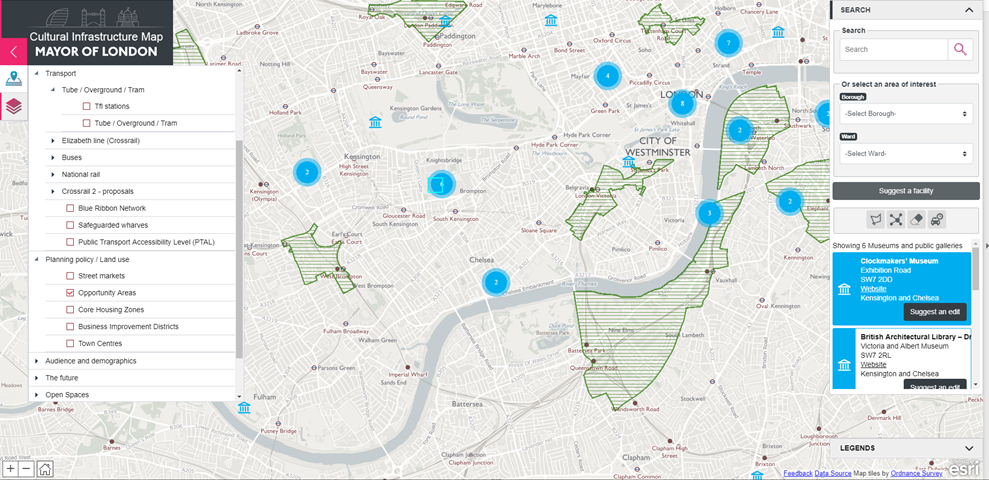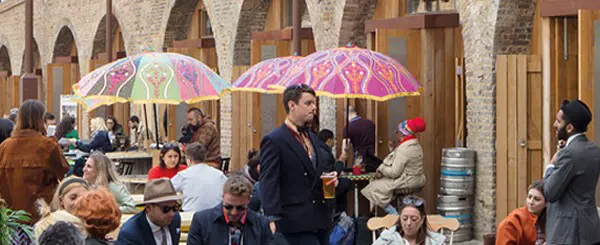The Mayor of London published his new
Cultural Infrastructure Plan, last month (March, 2019); as noted in Lichfields’
planning news, it focuses on cultural spaces and how the Capital should best plan to meet its cultural needs. The report makes clear that these spaces are at risk from land pressures, increasing business rates and permitted development rights. A call for action from planners is at the centre of this Plan, not least because the NPPF regards ‘cultural wellbeing’ as a crucial component of sustainable development
[1].
The Plan delves into how we can better understand our cultural infrastructure, from cultural ‘consumption’ (which includes spaces such as art galleries, museums and libraries) to the increasingly broad nature of cultural ‘production’ (including but not limited to artist studios, design workshops and creative co-working spaces). It coincides with the Mayor publishing a
Cultural Infrastructure Toolbox, the first of its kind, which also includes an interactive map. By understanding the differing cultural venues which make up London’s world class cultural infrastructure, only then can we start to take action.
Planning effectively for cultural spaces in London has become increasingly complex. Unsurprisingly, cultural uses are experiencing much of the same pressures to that of industrial and office uses: rising land prices, increasing business rates and pressure from higher value residential uses.
In response, the Cultural Infrastructure Plan is intended to sustain and enhance the cultural spaces within London by advocating collaborative solutions on a site-specific basis, whereby planners work alongside, developers, local authorities and cultural organisations. The Mayor’s Plan proses a call to action to 1) map where cultural spaces are within each Borough and 2) consider how we can enhance these spaces. The following questions addressed within the Plan are particularly crucial for our sector:
What is cultural infrastructure?
Cultural infrastructure, whilst critical to London’s economy, is often ill-defined. The Plan states this infrastructure encompasses the buildings, structures and places where culture is either consumed or produced. With the recent announcement of the Creative Enterprise Zones – the first ones being designated in December 2018 – we are seeing an increasing emphasis placed upon the creative economy; a sector which generates ‘£52bn for London each year, is the reason most tourists visit, [and] employs one in six Londoners’.[2] Our cultural spaces, beyond contributing to ‘cultural wellbeing’, are critical in terms of job creation, sector growth and maintaining London’s position as a world leader in cultural capital.
The Mayor’s Plan stresses the need to map this cultural infrastructure across the Capital to plan effectively. The cultural infrastructure map allows users to choose from 36 indicators (spanning from artists workspaces, community centres, dance halls, heritage at risk, pubs and theatres) to explore different locations across the Capital. The map (see extract, below), allows cultural spaces to be viewed at both Borough and Ward level. This can then be combined with context layers such as transport, planning policy, audience and demographics, and open spaces. For instance, the map below shows the results of combining the museums indicator with the Opportunity Zone context layer. Developers, planners and architects proposing new developments are encouraged to consider cultural spaces, particularly those deemed to be at risk, and seek to incorporate these spaces within their proposals.

Source: The Cultural Infrastructure Map (2019)
Planning for cultural infrastructure
The Cultural Infrastructure Plan outlines how we can better plan for cultural infrastructure, in accordance with the Draft London Plan policies, towards a ‘roadmap to 2030’
[3]. It identifies a ‘seven-point action plan’
[4] centred around mapping, sustaining and enhancing cultural spaces. Action 2 explicitly calls for planners to ‘plan for and create cultural infrastructure’
[5]. This includes reference to the role that Section 106 and Community Infrastructure Levey can play with regards to cultural infrastructure. Alongside funding, the plan calls for intensification of sites, re-purposing buildings and developing new sites to provide cultural spaces. It also highlights the potential role of meanwhile uses, a topic covered by Lichfields through our work for U+I (for more, read our recent
blog).
As well as creating new sites however, the Mayor calls for a more
collaborative approach to planning such spaces. This involves the co-operation of local authorities, cultural organisations, architects and planning organisations. For example, Hackney Borough Council, the London Legacy Development Corporation and creative co-working spaces are safeguarding cultural production sites by introducing planning policies which ensure rent is below market value. This is intended to safeguard 8,500 sqm of creative working spaces within new developments in
Hackney.
Whilst we are already seeing a number of co-operative solutions being implemented across the Capital, more is needed to sustain our world class cultural assets which are vital to both London’s economy and our sense of cultural wellbeing. The Mayor seems resolute that planners must play a key role in delivering future cultural spaces to enable our creative economy to thrive and for all of London to enjoy. As the Cultural Infrastructure Plan states, a first step must be for planners to answer this call to action.
[1] National Planning Policy Framework, (2019), paragraph 8[2] The Cultural Infrastructure Plan, Greater London Authority, (2019) p.7[3] The Cultural Infrastructure Plan, GLA, (2019), p.35[4] The Cultural Infrastructure Plan, GLA, (2019), p.38[5] The Cultural Infrastructure Plan, GLA, (2019), p.40




